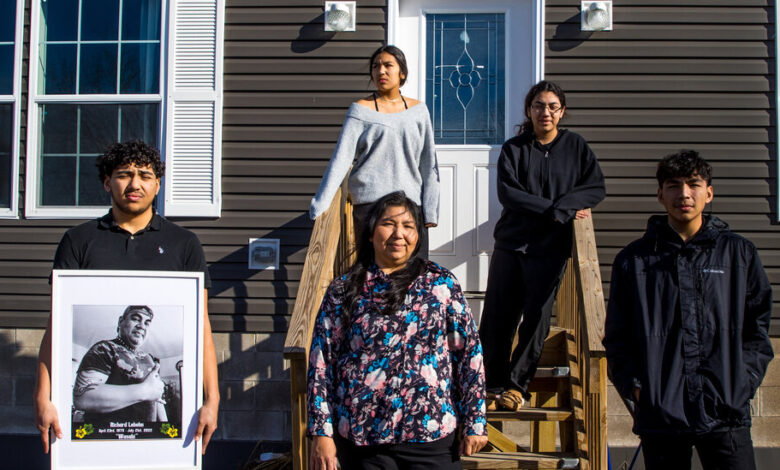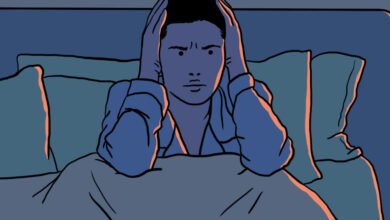One Family’s Road to Building a House Despite the Obstacles

Randa Martin always wanted high ceilings. Her partner, Richard Lebehn, longed for a chef’s kitchen like the ones in all the restaurants where he had worked.
The couple started getting closer to building their dream home after they moved in 2009 to the Saint Regis Mohawk Reservation, otherwise known Akwesasne, where Ms. Martin was born and raised.
Mr. Lebehn, originally from Pohnpei, an island in Micronesia, got a job as a chef at the local casino; Ms. Martin found work in a doctor’s office. They had moved from Myrtle Beach, S.C., where they met at a dance at the House of Blues in 2001. Ms. Martin wanted a village to help raise their expanding family.
First they rented apartments on the reservation, but those quarters were getting uncomfortably tight as their four children grew older. “Once you get to that age you need your own space, considering two of the children were 6 feet tall,” said Ms. Martin, 45.
Feeling an urgency to move into something bigger, Ms. Martin and Mr. Lebehn began thinking about finally becoming homeowners.
They weighed the avenues available to Indigenous people.
Most reservations in the United States are on land held in a federal trust, but some, like that of the Saint Regis Mohawk Tribe, are on restricted fee land, which is not subject to county and state taxes. Home buyers on federal trust and restricted fee land cannot apply for conventional mortgages for reasons including that lenders cannot foreclose on these homes without congressional assistance, an attorney for the tribe said.
The limitations contribute to a homeownership gap. White households were 36 percent more likely to own their homes than Native Americans in New York in 2021, and 19 percent more likely nationally, according to the U.S. Census Bureau.
To help make homeownership possible for tribal members, the federal government offers a few options.
In 1992, the U.S. Department of Housing and Urban Development created a lending program for Indigenous people known as Section 184. These mortgages are insured by the federal government, allowing lenders to foreclose on them if necessary. However, HUD permits roughly 200 lenders to offer these loans. According to a recent study by the Akwesasne Housing Authority, just one of those 200 lenders, 1st Tribal Lending in South Dakota, operates in New York.
It’s difficult for an out-of-state lender to get a license to operate in New York, said Juel Burnette, a branch manager at 1st Tribal Lending in Sioux Falls, S.D. In his experience, his company received more pushback from New York than any of the other states where 1st Tribal Lending is licensed to operate. The licensing department, he said, was slow.
If tribal members can get a loan, they wait up to a year for insurance from the only title company that operates in the state, said Mr. Burnette, who is enrolled with the Rosebud Sioux Tribe in Mission, S.D.
It often takes more than three years to complete the home buying process on a reservation in New York, said Iakowi:he’ne’ Oakes of the Haudenosaunee Confederacy, a union of Indigenous tribes, including the Mohawk, and executive director of the North American Indigenous Center of New York.
With reservations around the country plagued by land shortages, becoming a homeowner on a reservation depends on the availability of property, said Ms. Oakes, who lives with the Saint Regis Mohawk Tribe. “Most non-homeowners in our reservation have little to no opportunity to ever pursue the process unless they own land, and absolutely no one is selling,” she said.
Fortunately, Ms. Martin said, her family still had the 20 acres of land that they obtained through a treaty with the federal government.
The three-bedroom house she grew up in was torn down in 2022 because it had deteriorated, but her aunt offered a three-acre parcel, at $1,000 per acre, in a neighboring field her great-great grandparents had turned into farmland.
The Akwesasne Housing Authority guided Ms. Martin and Mr. Lebehn toward a Section 502 Single Family Direct Housing Loan from the United States Department of Agriculture to build a house on their three acres. Commonly known as “USDA loans,” these offer low interest rates and zero down payments to low-income households in rural areas. While they’re open to everyone who qualifies, the USDA is engaging in outreach programs to grow its work in tribal communities. In 2023, 17 USDA loans were borrowed by home buyers on reservations nationally, up from six in 2019, according to a department spokesman.
The couple first applied in the spring of 2020. It was the beginning of the pandemic, when workers quarantined and offices closed. They had to start their paperwork from scratch three times before it went through, Ms. Martin said.
They also sought a manufactured home builder, which was no easy feat with supply chain shortages and closures. “We searched high and low to find a reasonable price during the sky-high prices of Covid inflation,” Mrs. Martin said.
They considered scores of options from various home dealers in a three-hour radius before finding the perfect fit: a four-bedroom, three-bath with high ceilings to accommodate their sons’ heights and that chef’s kitchen for Mr. Lebehn.
As they waited and waited for their loan, the unspeakable happened. One afternoon in late July 2022, Mr. Lebehn came home early from the Akwesasne Mohawk Casino. He had recently moved from his chef’s role to a job in maintenance so he could work daytime hours and spend more time with his family. Feeling unwell, he laid down for a nap. He died in his sleep. The cause was a heart attack. He was 47.
“We buried him in the family cemetery which happened to be in the backyard of the future home site,” Ms. Martin said on a recent afternoon.
Ms. Martin, reeling from his unexpected death, feared that their dream home would never happen, especially since their loan application was now based on a single income. But the couple’s loan specialist, Mary Keenan, at the Akwesasne Housing Authority heard about Mr. Lebehn’s death and redid the application on Mrs. Martin’s behalf.
Ms. Keenan is not authorized to speak with the media, but the housing authority’s interim executive director, Kayla Herne, said the loan officer often shows a high level of dedication to the home buyers she works with. “If she hears about something like this happening, she will restart a loan,” Ms. Herne said. “Mary does it out of the kindness of her heart.”
In November 2022, Ms. Martin secured a $198,000 mortgage. Shortly after, the Saint Regis Mohawk Tribe’s Home Improvement Division awarded her a $10,000 grant to pay for the home’s foundation.
“I had shed so many tears already I didn’t think I had any more, but I did,” she recalled. “I was so happy to know our dreams were still coming true.”
It took another six months of excavating and building before Ms. Martin and her four children could move into their new digs in June 2023. There’s space for everyone to have a room.
That summer, representatives from the USDA planted a tree in their front yard in remembrance of Mr. Lebehn, and Ms. Martin plans to build an outdoor grilling station out back to further honor his memory.
Logan Lebehn, 20, said the new house inspired him to rally his siblings, Brody Lebhen, 18, Liana Lebehn, 13 and Lolani Lebehn, 11, to process their father’s death and to help their mother. “We really needed to get into this house so we could have that family dynamic where we all work together,” he said. “We noticed that we need to be here more for each other.”
On a day earlier this year, Ms. Martin and her children shared stories about the new house and Mr. Lebehn as they sat in the living room. A 24-by-30-inch photo of Mr. Lebehn sits in a frame on a table.
The kitchen has white cabinets and a large island. “We’re still unpacking. I heard it takes years to truly unpack,” Ms. Martin said. “I’m so grateful to be here every day.”
Source link






